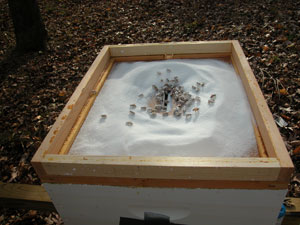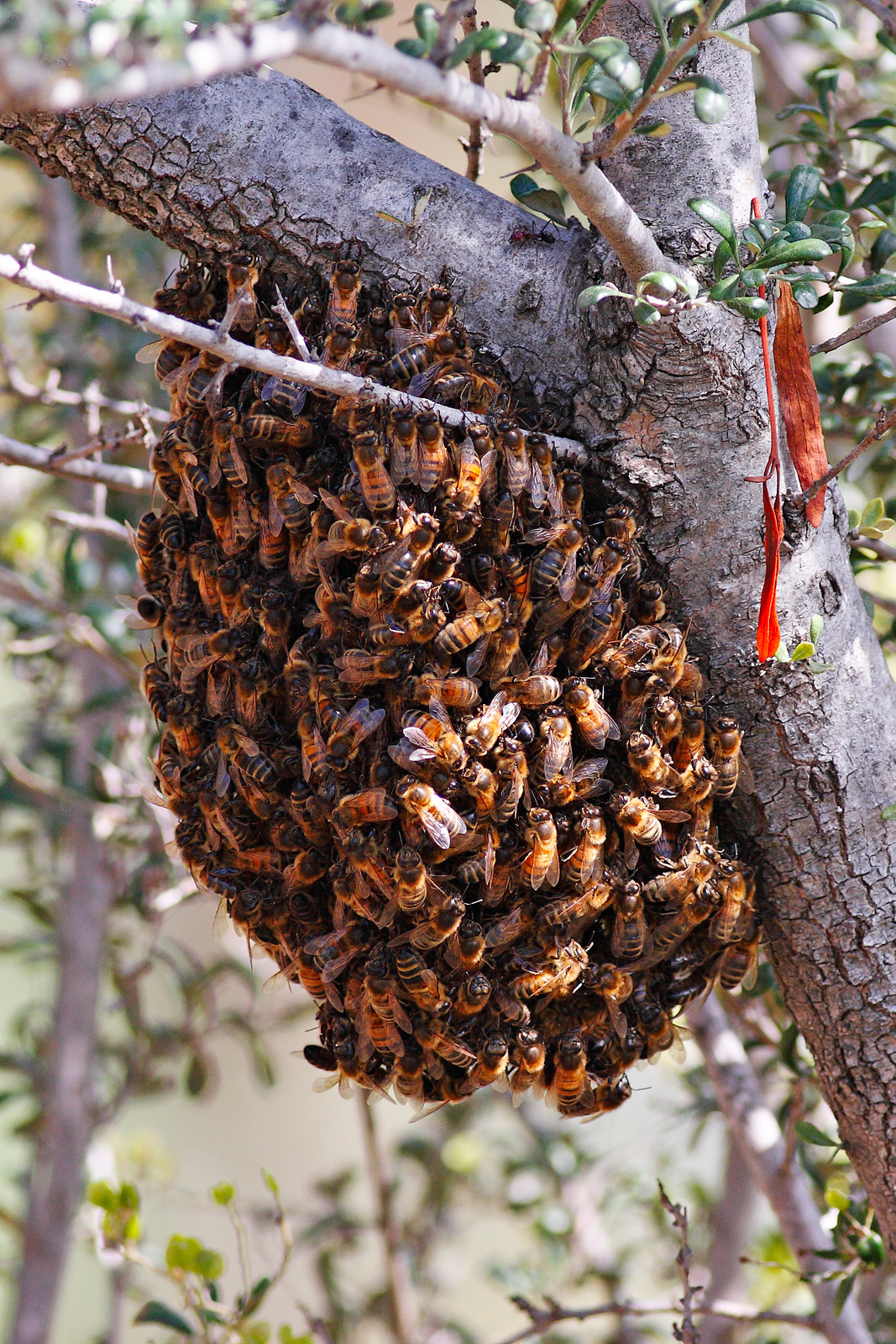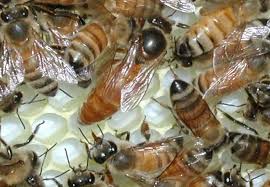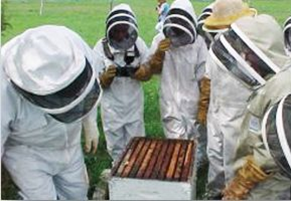Karessa Torgerson spoke at our December 8th meeting outlining the five most common beekeeper mistakes. Karessa is owner of Apicurious (www.api-curious.com), an EAS Master Beekeeper, co-founder of Nectar Bee Supply (www.shonnards.com/beekeeping), and board member of Tree Hive Bees (www.treehivebees.com). She serves on the Oregon Master Beekeeper committee and teaches and mentors for the program.
Our first hives can serve as our ‘tuition’ as we learn what not to do as beginners. Beginning beekeepers lose about 60% of their hives, compared to an average of 30% loss overall each year. It is very expensive to lose a colony, in lost dollars, frustration, and heartbreak. Many new beekeepers can give up after a season or two of losses, so it is important to try to remove some of the roadblocks to being successful. Karessa has identified are five common mistakes that new beekeepers make.
Mistake #1: Feeding “Wrong”
It is important to support your bees if they do not have enough resources in the hive. It is better to feed than to allow the bees to starve. However, you need to understand the needs of the hive based on the season, the weather, the forage available, and the spring buildup plan (hobbyist or commercial) in order to determine if you need to feed your bees, and then feed appropriately. Feeding is only necessary if the bees have not been able to store enough resources on their own, so be sure to understand the status of your hive before feeding.
FALL: Hives need between 60-80 pounds of honey and several good frames of pollen to get through the winter. The pollen supplies are also very important; one study showed that 75% of colonies without enough protein during the winter did not build up in the spring and eventually collapsed.
Beginning in late August/September, monitor the amount of honey and pollen in the hive and feed if necessary. You can use heavy syrup or dry sugar to increase the carbohydrate (honey) stores, and pollen patties or dry pollen supplement to increase the protein stores. Using syrup can add moisture to the hive and encourage robbing, so use dry sugar later in the fall as our wet winter approaches. Nurse bees feed directly on the pollen patties, storing it in their bodies, and can live longer. The dry pollen is put in frames by the bees and not consumed directly. If you are trying to build up stores for the winter, it may be best to use the dry pollen.

Once the protein stores are sufficient for the winter, then be conservative about further pollen supplements to prevent encouraging a premature a spring buildup. It is very important to make sure that there continues to be enough carbohydrates in the hive during the winter, because the bees use this to keep warm. You can chance adding sugar to the hive if necessary on warm days in winter (>55 and dry), but it is best to have built the stores up in the fall so that there is enough honey for the cluster to overwinter.
SPRING: The goal of feeding in the early spring is to build up a sufficient population so that the bees can harvest the maximum amount of nectar and pollen when it begins to flow. The nectar flow period can be short in our area, and if the bees are not at optimum strength during the flow they may not be able to store enough for the next winter, thus necessitating further feeding.
Feeding in the spring should be done conservatively and only if the bees need support to build up for the nectar flow. In the spring, feed a lighter syrup and pollen patties. Robbing is not usually an issue in early spring, and the pollen patties may boost the nurse bees health as they raise the spring brood. Randy Olivier has a good article comparing different protein supplements options (www.scientificbeekeeping.com/bee-nutrition).
However, it is important that the bees do not build up their population too fast in the spring so that you do not promote swarming. Beekeepers who want to make splits, and commercial beekeepers who need to maximize the bee population for the almond pollination in February will feed aggressively in spring, but hobbyists may not need to feed at all.
March is the most common month for bees to starve. Watch for the first day that it is safe to open the hive (60 degrees, dry, and not too windy) and check the hives resources. Monitor the amount of brood and protein in the hive and determine if the bees can feed the brood given their pollen stores and the availability of pollen and weather. If you feel that a pollen supplement is necessary, be conservative on how much you feed and only feed until the weather is nice enough and there is enough forage nearby.
One mistake that Karessa made was to begin feeding in the spring, and then interrupt the feeding due to a trip. The bees had become dependent on the level of food available while she was feeding, and suffered a major setback when the food was no longer provided.
Mistake #2: Wishy-Washy Mite Management
It is so important that you are doing something about mites. It does not have to be a synthetic treatment. It will take a long time for bees to develop a resistance to varroa mites and reach a balance between parasite and host, but until then the mites will kill the bees. Recent research has shown that beekeepers who do nothing at all and have colonies that collapse will have bees that abscond and take the mites with them to other apiaries.
Even if the bees in those apiaries have some resistance, they cannot handle wave after wave of varroa mites coming into the hive. They won’t survive. A lot of people are arguing that it is irresponsible to do nothing.
There are mechanical controls like drone trapping, and organic treatments that are effective. Always sample your mite levels before you treat as well as after to make sure that the treatment was effective. Mite numbers could remain elevated after a treatment if the conditions were not ideal. Wait until most of the capped brood has hatched releasing the mites that were hidden from the treatment. It takes 21 days for a brood cycle, so monitor 14 – 21 days after treatment.
Mite loads can double every month, so it’s important to monitor once a month since mites can overwhelm a colony quickly. Mites carry viruses, and the virus complex is more deadly now. The treatment level used to be 5%, but now the recommendation is 2% or 2 mites per 100 bees (6 mites per 1/2 cup of bees).
Using a sticky board to monitor mite count is not recommended because you do not have a good idea of the number of bees in the hive and so cannot determine the ratio of mites to bees. You need to know the infestation ratio in order to know when to treat.
Sugar Shake: A sugar shake can be just as effective as an alcohol wash if done properly. Collect a scant 1/2 cup bees (4/10 cup) by knocking the bees off of a brood frame. You can also run a cup down a frame gently over the backs of the bees and they will fall in the cup, but John suspects that you will get a lower count than you would get by knocking the bees from the frame. Use a brood frame because the mites are most likely to be on the nurse bees. Put the bees into a jar and sprinkle 1 or 2 tablespoons of powdered sugar onto the bees. Shake vigorously for a few minutes and then let the jar sit in the sun for a minute or to for the ‘bake’. The bake increases the accuracy of the count. Put a screened top on the jar and shake onto a white dish that has a little water in it. The water makes it easier to see the mites in the sugar.
Use the same monitoring method for the before and after mite counts so that you are comparing apples to apples.
Sample at least 10% of the hives in your apiary, choosing some weak, mediocre, and strong hives. If you need to treat one hive, treat them all; only treating heavily invested hives is no better than doing nothing.
The folks at OSU see mite feces almost always when they are called in to diagnosis a failed or failing hive. Most of the time the beekeepers are attributing the failure to wasps, disease, or other causes, when it’s basically a mite infestation. If you have a weak hive, test for mites!
All mite treatments should be complete by August so that the bees have time to recover and rebuild the population that will take them through winter.
Mistake #3: Not Understanding Swarms
When your colony swarms, it usually loses more than 40% of the bees, the old queen, and some food. Three weeks later, the last of the brood from the old queen is emerging. During these first 3 weeks,, the colony population remains at 60% as the old brood emerges and replenishes the colony. In the next 3 weeks, the new queen begins laying, but her brood will not emerge for another 3 weeks. Given the normal die-off rate without brood to replenish the, the hive can drop to as low as 30% of the original population in the 6th week. There are fewer resources because there are few bees to forage. If the swarm happens 6 weeks before nectar flow, the hive could be in real trouble and need to be fed.
The bees that leave the hive in a swarm take about 1/6 of the varroa mites with them; most of the mites remain in the hive with a reduced population of bees. The first generation of bees from the new queen can be highly parasitized and very vulnerable.
Swarming does give an opportunity to treat for mites during the period when there is no capped brood – about 3 weeks after the swarm. Swarming is only good for mite control in the bees that leave, but these bees are vulnerable due to the high risk of failure in creating a viable colony in time for nectar flow. Swarming is a bad thing for the mother hive for both mite load and foraging efficiency.
If you have a hive that has swarmed, you can add a few frames of uncapped brood and eggs to the colony from a strong hive. Open brood pheromone keeps the worker bees from laying, boosts the population a bit as the eggs hatch, and boosts the morale of the hive.
It is a good opportunity to re-queen the hive after a swarm. If the bees begin queen cells on the eggs in the frame you add, it means they are queen-less and are receptive to a new queen. Introducing a mated queen right after a swarm cuts the time until the new eggs hatch down to 3 weeks.
If you capture a swarm, you need to feed them until they have time to build up their population and create the wax frames needed to store resources. The population of the swarm will drop by 50% before the newly laid eggs will hatch.
Karessa has a more detailed article on the effects of swarming on Api-Curious.com (will-your-colony-swarm).
Mistake #4: Being Unaware of Queen Status
The Bee Informed Partnership surveys suggest that hives with queen events (lost or failing queens) are three times more likely to die. If you are unaware that your colony is struggling, and you are not doing anything to support it, your colony is at a greater risk of dying.
The brood pattern in the hive is a rich source of information. We check the brood for signs of disease, but the pattern can indicate queen health. If the pattern is not solid but spotty, then replace the queen – you are saving the entire colony. Spotty brood is brood of all different ages together, with a lot of empty cells. A good brood pattern is solid and has brood of the same age grouped together. If you let the colony struggle on with a failing queen, the colony may eventually die. They won’t be able to reach a population level sufficient to forage for enough resources. You can use the failing queen in a nuc as a safety measure in case the new queen fails.
The queen is the genetic mother of the hive, She needs to be well-mated and in top performance. If she’s not, your colony will not thrive.
If you see queen cells of different ages – the bees are trying to supercedure, not swarm. Theses cells are usually on the face of a frame and not grouped at the bottom. The bees think that it is necessary to replace the queen, so this is a good time to re-queen.
It can be a good practice to replace the queen each year in August//September. An older queen produces less pheromone so there is a greater chance of swarming. Fall is a good time to re-queen, but give yourself enough time for failure. Everyone that John knows whose livelihood depends on their bees re-queens at least 1/2 of their hives each year. Annual re-queening is becoming standard practice.
Mistake #5: Not Using Resources
It is difficult to learn beekeeping by reading books – you need to reach out to members of your club and to other beekeepers to take advantage of so much experience. Make sure that your sources are good. The Oregon State Beekeeper’s Association has a good forum, but you’ll need a think skin – it can get a bit rough. The following list are a few of Karessa’s favorites:
- beeinformed.org: The Bee Informed Partnership gathers survey data from thousands of beekeepers every season to understand how different management practices affect honey bee health, and we report our findings back to the industry.
- scientificbeekeeping.com: A record of biologist Randy Oliver’s learning process as he tries to understand aspects of colony health and productivity, and the reasons why various management techniques work (or don’t). (Grass Valley, CA)
- www.honeybeesuite.com: Explores ways that we, as citizens of the earth, can help the bees that keep food on our tables and beauty in our lives. (western Washington)
- www.api-curious.com: Karessa’s mission is to significantly reduce honey bee colony mortality, especially in the Pacific Northwest.
- UC Davis Bee News: A free bi-monthly newsletter from the UC apiaries.
- Oregon State University Master Beekeeper Program: a cooperative effort between Oregon State University and the Oregon State Beekeepers Association to contribute to both the health of honey bee colonies and the integrity of the practice of beekeeping throughout the region.
- The Beekeeper’s Handbook by Diana Sammataro and Alphonse Avitabile. “the best single-volume guide to the hobby and profession of beekeeping.”






